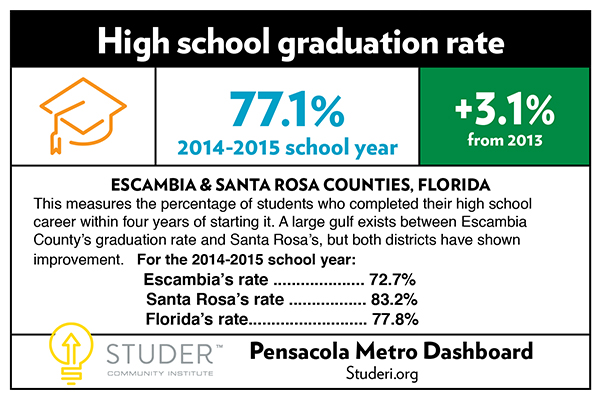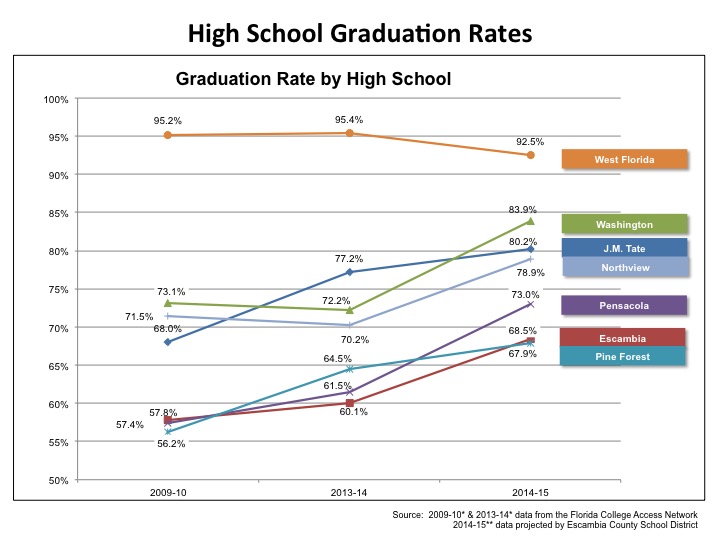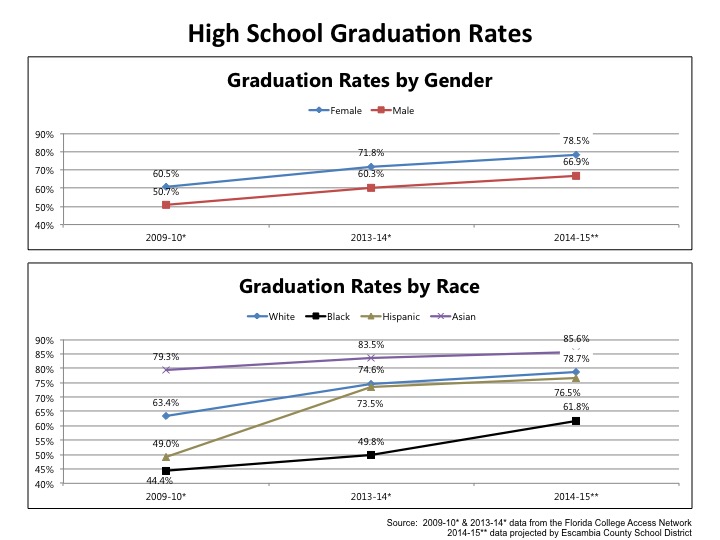Escambia County celebrates graduation rate milestone
- January 5, 2016
- / Reggie Dogan
- / education

West Florida senior Raleigh Nesbitt delivering her speech during the 2015 graduation ceremony.
Escambia County School District is celebrating a 6.6 percent rise in its high school graduation rate, the largest increase in a decade.
For the class of 2015, Escambia’s graduation rate jumped to 72.7 percent, just under 5 percentage points below the statewide graduation rate of 77.8 percent, according to new data released by the Florida Department of Education.
Malcolm Thomas, superintendent of Escambia schools, said the improved graduation rate is “one of the most positive pieces of data I’ve had.” He credited the increase to an increased emphasis on high-risk students and the growth in career academies in middle and high schools.
“What you’re seeing today and what we celebrate didn’t happen in 2015,” Thomas said. “It started back in 2009 and 2010, and a big part for that group is career academies.”
Since 2009, middle and high school career academies in the county have gone from 13 to 63 in 2015. More than 18,000 students — nearly half of all students in Escambia schools — are enrolled in a career academy.
The academies are curriculum tracks, tied to an industry or business, that combine traditional academics with the real world application of those concepts based on the industry track the academy is tied to.
Research suggests that career academies engage students more and may lead to higher graduation rates and better job prospects.
The high school graduation rate is one of 16 benchmark metrics that the Studer Community Institute measures in the Pensacola Metro Dashboard. Developed with the University of West Florida, the dashboard is a snapshot of the educational, economic and social well-being of the community.
Thomas was especially proud that every high school in the district, with the exception of West Florida High School, made significant increases in their graduation rates. West Florida’s graduate rate dropped to 92.5 percent, three percentage points below the 2014 rate.
Pensacola High School made the biggest jump, climbing to 73 percent, up 16 percentage points from 57.8 in 2009.
Escambia, Northview, Pine Forest, Tate and Washington all raised their graduation rates by a minimum of 10 percentage points this year.
“This is such a great news story for our students and our community,” Thomas said. “We knew the day would come when we got this big bump, and this just happens to be the year.”
Graduation rates also spiked among black students. The rate increased significantly to 61.8 in 2015, an increase of more than 17 percentage points — 44. 4. Percent — in 2010.
Thomas said principals and counselors put an extra focus on at-risk students, poring over data and keeping tabs on their attendance and classroom work. He also said the addition of two sessions of summer school, night school and the availability of online virtual schools played a role in the dramatically improved graduation rates.
“I think all of those things combined in the system gave great opportunities to students,” Thomas said. “But it’s not all about the system. It’s about the family and the students buying into this idea that being a high school graduate is important.”
Overall, graduation rates statewide for the class of 2015 resulted in Florida achieving a 12-year high. The statewide graduation rate climbed to 77.8 percent, an increase of more than 18 percentage points since 2003-04 and 1.7 percentage points from last year.
In Santa Rosa County, the four-year graduation improved slightly, up from 82.8 last year to 83.2 percent in 2015.
The county’s graduation rate improved three years in a row, rising 5.4 percentage points since 2011.
Gulf Breeze High School ranked No. 2 in the district with a 97.2 percent graduation rate, followed by Milton at 91.1. All six public high schools in the district surpassed 85 percent.
Santa Rosa School Board Chair Jennifer Granse said the board was proud of the students and praised teachers for their hard work.
“This is what we work for as educators: To provide a high-quality education for our students that is relevant to the world of work and post-secondary advancement,” she said.
Santa Rosa schools Superintendent Tim Wyrosdick said the School District’s graduation rate improvement each year requires a committed focus by parents, teachers, school board members and administrators.
While Wyrosdick is proud of Santa Rosa’s graduation rate, the bar is set for higher achievement.
“Although we have increased the graduation rate for five consecutive years, we will continue to align curriculum and manage the classroom until each student in Santa Rosa County graduates and can successfully move to the next level of career preparation,” he said. “A 100 percent graduation rate is achievable.”
Florida's graduation rate counts students who earn a standard diploma. Students who earn a special diploma, a GED-based diploma, a certificate of completion, or have been retained and are still in school after four years are not counted in the calculation.
The graduation rate measures the percentage of students who graduate within four years of their first enrollment in ninth grade, according to the state.
PREVIOUS STORY
The Florida Department of Education released today the state’s four-year high school graduation rates for students in the class of 2015, and Escambia County School District rose to 72.7 percent, a 6.6 percentage point increase over last year.
Since 2010-2011, Escambia’s graduation rate has increased 15 percentage points, reaching its highest level in recent years.
Santa Rosa County improved its graduation rate to 83.2 percent, a 0.4 percentage point increase over the previous year and 5.4 percentage points since 2010-2011.
Statewide, Florida’s graduation rate reached a 12-year high, climbing to 77.8 percent, an increase of more than 18 percentage points since 2003-2004 and 1.7 percentage points over last year.
The high school graduation rate is one of 16 benchmark metrics that the Studer Community Institute measures in the Pensacola Metro Dashboard. Developed with the University of West Florida, the dashboard is a snapshot of the educational, economic and social well-being of the community.
Upon on the release of the 2015 graduation rates, Florida Commissioner of Education Pam Stewart congratulated the graduates and gave high marks to parents and teachers who supported the students in their education.
“This news is further evidence that Florida’s public education system is serving our students well,” Stewart said in a news release. “More students are achieving success by earning a diploma, which will enable them to pursue higher education and meaningful careers.”
Graduation rates across the country have been rising since 2002, when the No Child Left Behind Act required states to improve their high school graduation rates.
U.S. public high schools this year recorded a four-year graduation rate of 81 percent, an all-time high.
In 2005, the states agreed on a uniform measure of the graduation rate. That meant tracking students all four years they’re in school.
The graduation rate measures the percentage of students who finish school within four years of their first enrollment in ninth grade.
The rate is calculated for an adjusted cohort of students — taking into account those who enter or exit the group.
Florida’s graduation rate only considers students who receive a standard diploma as graduates in the calculation. Students who earn a special diploma, A GED-based diploma, a certificate of completion or have been retained and are still in school after four years are counted as non-completers in the calculation.
A complete report to come later.



 CivicCon launches with a look at good growth in cities
CivicCon launches with a look at good growth in cities
 Building stronger brains one baby, one parent at a time
Building stronger brains one baby, one parent at a time
 SCI debuts commercial on Early Learning City
SCI debuts commercial on Early Learning City
 Entrecon: World class speakers and an opportunity to sharpen skills
Entrecon: World class speakers and an opportunity to sharpen skills
 PYP Quality of Life survey 2017
PYP Quality of Life survey 2017
 EntreCon Pensacola 2016: A look back
EntreCon Pensacola 2016: A look back
 Leadership tip: getting better employee takeaways
Leadership tip: getting better employee takeaways
 Leadership tip: be interested instead of interesting
Leadership tip: be interested instead of interesting
 Leadership tip: delivering difficult messages
Leadership tip: delivering difficult messages
 Brain Bags boost Arc, Early Childhood Court programs
Brain Bags boost Arc, Early Childhood Court programs